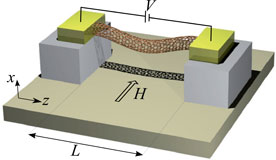A team of researchers at the University of Gothenburg, Sweden, has discovered that electromechanical principles are applicable at the nanoscale also. So the distinct properties of carbon nanotubes could be combined with physics and be applied in future quantum computers.
According to Gustav Sonne of the Physics Department at the University of Gothenburg, the team has been researching on how carbon nanotubes behave when they are induced as per the laws of quantum mechanics.
 GU.SE’s suspended carbon nanotube can be made to vibrate like a guitar string.
GU.SE’s suspended carbon nanotube can be made to vibrate like a guitar string.
Various microelectromechanical units are used to detect and identify whether a process has occurred or the presence of a specific substance. It is not possible to track these without instruments. For example, it is important to sense of high speeds to activate the airbag in a car accident. All these components incorporate mechanical and electronic properties to be able to respond to external changes.
Sonne has downsized research to the nanometer scale from the micrometer scale by studying nanoelectromechanical systems. Suspending carbon nanotubes between electrical contacts forms the basis of the research. He has determined how vibrations in the suspended tubes could be combined with a current passing through them.
The team studied how the systems comprising nano, weightless mechanical oscillators could be applied in quantum mechanics, and its impact on the measurements. By conducting this research, several innovative mechanisms for electromechanical coupling have been discovered. This could also result in the identification of unusual physical phenomena, which could facilitate research on quantum computers.
Nanotubes are strong, lightweight, and possess high electrical and thermal conductivity. They can help produce considerably high-strength composite materials.
The research paper titled, ‘Mesoscopic phenomena in the electromechanics of suspended nanowires,’ was presented in the Department of Physics, and was supervised by associate professor Leonid Gorelik.
Source: http://www.gu.se/